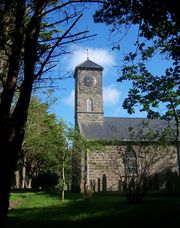Sark
|
Sèr
Sercq Sark |
||||||
|---|---|---|---|---|---|---|
|
||||||
| Anthem: "God Save the Queen" (official) "Sarnia Cherie" (official for occasions when distinguishing anthem required) |
||||||
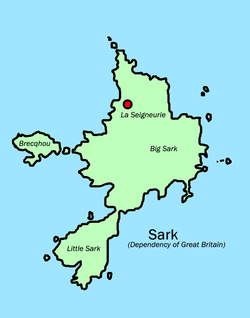 A map of Sark with Brecqhou to the west.
|
||||||
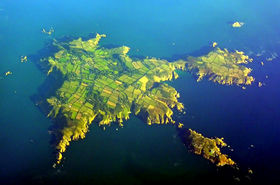 Aerial view of Sark; North is to the lower left, Little Sark in the upper right and Brecqhou at bottom right.
|
||||||
| Capital | La Seigneurie1 | |||||
| Official language(s) | English, French | |||||
| Recognised regional languages | Sercquiais | |||||
| Government | ||||||
| - | Seigneur of Sark | John Michael Beaumont | ||||
| Part of the Bailiwick of Guernsey (Crown dependency of the British Crown) |
||||||
| - | Elizabeth I of England granted the fief to Hellier de Carteret | 1565 | ||||
| Area | ||||||
| - | Total | 5.45 km2 2 sq mi |
||||
| Population | ||||||
| - | estimate | 600 | ||||
| - | Density | 110.09/km2 285.1/sq mi |
||||
| Currency | Pound sterling2 (GBP) |
|||||
| Time zone | GMT | |||||
| - | Summer (DST) | (UTC+1) | ||||
| Internet TLD | .gg (Guernsey) | |||||
| Calling code | +44 (0)1481 | |||||
| 1 | Residence of the head of government. Sark has no capital | |||||
| 2 | See Guernsey pound, notes and coins not legal tender outside Guernsey | |||||
Sark (French: Sercq; Sercquiais: Sèr) is a small island in the Channel Islands in southwestern English Channel. It is a self-governing British crown dependency, with its own set of laws based on Norman law and its own parliament, although for some administrative purposes it is considered a part of the Bailiwick of Guernsey. It has a population of about 600. Sark's main industries are tourism, crafts and finance. Sark has an area of 5.45 square kilometres (2.10 sq mi)[1].
Contents |
Geography and geology

Sark consists of two main parts, Greater Sark, located at about 49° 25' N x 2° 22' W, and Little Sark to the south. They are connected by a narrow isthmus called La Coupée which is 90 metres (300 ft) long and has a drop of 100 metres (330 ft) on each side[2]. Protective railings were erected in 1900; before then, children would crawl across on their hands and knees to avoid being blown over the edge. There is a narrow concrete road covering the entirety of the isthmus, built in 1945 by German prisoners of war under the direction of the Royal Engineers. Due to isolation, the inhabitants of Little Sark had their own distinct form of Sercquiais, the native Norman dialect of the island.

The highest point on Sark is 114 metres (374 ft) above sea-level[2]. A windmill, dated 1571, is found there, the sails of which were removed during World War I. This high point is named Le Moulin, after the windmill. The location is also the highest point in the Bailiwick of Guernsey. Little Sark had a number of mines accessing a source of galena.[3] At Port Gorey, the ruins of silver mines[4] may be seen. Off the south end of Little Sark are the Venus Pool and the Adonis Pool, both natural swimming pools whose waters are refreshed at high tide.
The whole island is extensively penetrated at sea level by natural cave formations, some of which are only safely accessible at low tide.
Sark is made up mainly of metamorphic rock types called biotite, amphibolite and granite gneisses, intruded by igneous magma sheets called quartz diorite. Recent (1990-2000[5]) geological studies and rock age dating by geologists from Oxford Brookes University shows that the gneisses mainly formed around 620-600 million years ago during the Late Precambrian-age Cadomian Orogeny. The quartz diorite sheets were intruded during this Cadomian deformation and metamorphic event. All the Sark rocks (and nearby Channel Islands of Guernsey & Alderney) formed during geological activity in continental crust above an ancient subduction zone. This geological setting would have been analogous to the modern day subduction zone of the pacific ocean plate colliding and subducting beneath the North and South American continental plate.
Sark also claims jurisdiction over the island of Brecqhou, only a few hundred feet west of Greater Sark. It is a private island that is not open to visitors. Since 1993 Brecqhou has been owned by David Barclay, one of the Barclay brothers, co-owners of The Daily Telegraph. They contest Sark's control over the island.
History
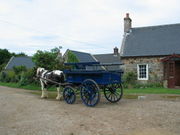
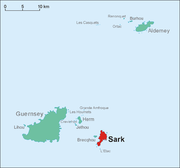
The Veneti tribe almost certainly possessed the island in ancient times. These people were subdued by the Roman Empire in around 56 BC and the island would have been annexed to the empire. Following the end of the Roman Empire and before the middle of the tenth century Sark had probably been an appendage of one of the Breton speaking kingdoms. After around 933 it became a part of the Duchy of Normandy which became united with the Crown of England after 1066. In the thirteenth century, Sark was used as a base of operations by the French pirate Eustace the Monk after he served King John of England. Although populated by monastic communities in the medieval period, Sark was uninhabited in the 16th century and used as a refuge and raiding base by Channel pirates. Helier de Carteret, Seigneur of St. Ouen in Jersey, received a charter from Queen Elizabeth I to colonise Sark with 40 families from St. Ouen on condition that he maintained the island free of pirates.
An attempt by the newly settled families to endow themselves with a constitution under a bailiff, as in Jersey, was put down by the authorities of Guernsey who resented any attempt to wrest Sark from their bailiwick.
In 1844, desperate for funds to continue the operation of the silver mine on the island, the incumbent Seigneur, Ernest le Pelley, obtained crown permission to mortgage the Fief of Sark to local privateer John Allaire; but the mine company went bankrupt, and he was unable to keep up the mortgage payments. In 1849, his son, Pierre Carey le Pelley, the new Seigneur, was forced to sell the seigneurie of Sark to Marie Collings, daughter and heiress of Allaire, for £6,000. [6]
During World War II, the island was occupied by German forces from 1940–1945, as were the other Channel Islands, and was the site of a British raid called Operation Basalt.
Recent history
One-person invasion attempt
In August 1990 an unemployed French nuclear physicist named André Gardes attempted a singlehanded invasion of Sark, armed with a semi-automatic weapon. The night Gardes arrived he put up signs declaring his intention to take over the island the following day at noon. He was arrested while sitting on a bench, changing the gun's magazine and waiting for noon to arrive, by the island's volunteer Constable.[7][8]
Transition to elected government
In 2008, Sark dismantled its 443-year old feudal system of government on the premise that this was necessary to comply with the European Convention on Human Rights. On 16 January 2008 and 21 February 2008, the Chief Pleas approved a law which introduced a 30-member chamber, with 28 members elected in Island-wide elections, one hereditary member and one member appointed for life.[9] On 9 April 2008, the Privy Council approved the Sark law reforms,[10] and the first elections under the new law were held in December 2008 and the new chamber first convened in January 2009.[11][12][13]
Politics
Sark was considered the last feudal state in Europe, and together with the other Channel Islands, the last part of the Duchy of Normandy still belonging to the Duke of Normandy, who since the Battle of Hastings in 1066 is also the King or Queen of England or its successor states. Formally, the Seigneur holds it as a fiefdom from the Duke of Normandy, reenfeoffing the landowners on the island with their respective parcels. The political consequences of this construction were abolished in recent years, particularly in the reform of the legislative body, Chief Pleas, which took place in 2008.
Seigneur
John Michael Beaumont is the current and twenty-second Seigneur of Sark, inheriting the position in 1974. He lives at La Seigneurie.
The Seigneur of Sark was, prior to the constitutional reforms of 2008, the head of the feudal government of the Isle of Sark (in the case of a woman, the title was Dame). Many of the laws, particularly those related to inheritance and the rule of the Seigneur, had changed little since they were enacted in 1565 under Queen Elizabeth I. The Seigneur retained the sole right on the island to keep pigeons and was the only person allowed to keep an unspayed bitch.[7][14]
Seneschal
On Sark the Seneschal is the former head of the Chief Pleas and the judge of the island. The complete list of all the Seneschal of Sark from 1576 [15] is as follows:
- Jean de Carteret (1576-15/7/1675)
- Pierre Gibault (15/7/1675-1680)
- Thomas de Beauvoir (1680–1683)
- Phillipe Dumeresq (1683–1702)
- Jean Payne (1702–1707)
- Philippe de Carteret (1707–1744)
- Henri de Carteret (1744–1752)
- Phillipe le Masurier (1752–1777)
- Henri le Masurier (1777–1785)
- Amice le Couteur (1785–1808)
- Jean le Couteur (1808–1812)
- Jean Falle (1812–1830)
- Elie le Masurier (1830–1841)
- Philippe Guille (1841–1851)
- Thomas Godfray (1851–1876)
- William de Carteret (1876–1881)
- Abraham Baker (1881–1891)
- Thomas Godfray (1891–1920)
- Kenneth Campbell (1920–1922)
- Ashby Taylor (1922–1925)
- Frederick de Carteret (1935–1937)
- William Carré (1937–1945)
- William Baker (1945–1969)
- Bernard Jones (1969–1979)
- Hilary Carré (1979–1985)
- Lawrence Philip de Carteret (1985–2000)
- Reginald J. Guille (2000–present)
Tenants
Pursuant to the royal letters patent, the Seigneur was to keep the island inhabited by at least 40 armed men. Therefore, from his lands, 39 parcels, each sufficient for one family, were subdivided and granted to settlers, the Tenants. Later, some of these parcels were dismembered, and parts of the Seigneurial land were sold, creating more parcels.
Originally each head of a parcel-holding family had the right to vote in Chief Pleas, but in 1604 this right was restricted to the 39 original tenements required by the Letters Patent, the so-called Quarantaine Tenements (quarantaine: French for a group of forty). The newer parcels mostly did not have the obligation to bear arms. In 1611 the dismemberment of tenements was forbidden, but the order was not immediately followed.
In Sark, the word tenant is used (and often pronounced as in French) in the sense of feudal landholder rather than the common English meaning of lessee. Originally, the word referred to any landowner, but today it is mostly used for a holder of one of the Quarantaine Tenements.
Chief Pleas
Chief Pleas (French: Chefs Plaids; Sercquiais: Cheurs Pliaids) is the parliament of Sark. Until this decade, it consisted of the Tenants, and 12 Deputies of the people as the only representation of the majority, an office introduced in 1922. The Seigneur and the Seneschal (who presides) are also members of Chief Pleas. The Prévôt, the Greffier, and the Treasurer also attend but are not members; the Treasurer may address Chief Pleas on matters of taxation and finance.
The executive officers on the island are:
- The Seneschal (President of Chief Pleas and Chief Judge) and the Deputy Seneschal
- The Prevôt (Sheriff of the Court and of Chief Pleas) and the Deputy Prevôt
- The Greffier (Clerk) and the Deputy Greffier
- The Treasurer (Finances)
- The Constable (the senior policeman and administration) and the Vingtenier (the junior policeman)
Seneschal, Prevôt, Greffier and Treasurer are chosen by the Seigneur; Constable and Vingtenier are elected by Chief Pleas.
Since 2000, Chief Pleas has been working on its own reform, responding to internal and international pressures. On 8 March 2006 by a vote of 25–15 Chief Pleas voted for a new legislature of the Seigneur, the Seneschal, 14 elected landowners and 14 elected non-landowners.[16] But it was made plain that this option was not on the table. Offered two options for reform involving an elected legislature, one fully elected, one with a number of seats reserved for elected Tenants, 56% of the inhabitants expressed a preference in a totally elected legislature.[17] Following the poll, Chief Pleas voted on 4 October 2006 to replace the 12 Deputies and 40 Tenants in Chief Pleas by 28 Conseillers elected by universal adult suffrage.[18] This decision was suspended in January 2007 when it was pointed out to Chief Pleas that the 56% versus 44% majority achieved in the opinion poll did not achieve the 80% majority required for the constitutional change. The decision was replaced by the proposal that Chief Pleas should consist of 16 Tenants and 12 Conseillers both elected by universal adult suffrage from 2008–2012 and that a binding referendum should then decide whether this composition should be kept or replaced by 28 Conseillers.[19] This proposal was rejected by the Privy Council and the 28 Conseiller option was reinstated in February 2008 and accepted by Privy Council in April 2008.[20]
In 2003, Chief Pleas voted to vary the longstanding ban on divorce in the island by extending to the Royal Court of Guernsey power to grant divorces.
The list of current Officers of the Island of Sark:
- Seneschal - Lieutenant Colonel Reginald John Guille
- Deputy Seneschal - Jeremy La Trobe-Bateman
- Prevôt - Alfred William John Adams
- Deputy Prevôt - Kevin Neil Adams (son of Alfred William John Adams)
- Greffier - Trevor John Hamon
- Deputy Greffier - John Hamon (father of Trevor John Hamon)
- Treasurer - Mrs Wendy Kiernan
- Constable - Caragh Couldridge
- Vingtenier - Matt Joyner
Clameur de Haro
Among the old laws of the Channel Islands is the old Norman custom of the Clameur de Haro. Using this legal device, a person can obtain immediate cessation of any action he considers to be an infringement of his rights. At the scene, he must, in front of witnesses, recite the Lord's Prayer in French and cry out "Haro, Haro, Haro! À mon aide mon Prince, on me fait tort!"[14] ("Haro, Haro, Haro! To my aid, my Prince! I am being wronged!"). It should then be registered with the Greffe Office within 24 hours. All actions against the person must then cease until the matter is heard by the Court. The last Clameur recorded on Sark was raised in June 1970 to prevent the construction of a garden wall.[7]
Sercquiais
Sercquiais (Sarkese, or sometimes called Sark-French) is a dialect of the Norman language still spoken by older inhabitants of the island.[21] Its use has declined in recent years due to a large influx of people who have moved to Sark.[22]
Education
Sark generally follows the education system of England and Wales.
Sark has one school, the Sark School, which takes residents from the ages of 4 to 15.[23] Pupils wishing to obtain a GCSE or A-level qualification often finish their education in Guernsey or in England. Though, since 2006, a limited number of GCSEs have been offered to pupils at Sark School.
Transport
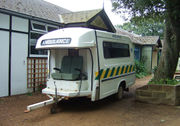
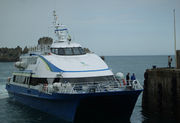
The island is a car-free zone[24] where the only vehicles allowed are horse-drawn vehicles, bicycles, tractors, and battery-powered buggies or motorised bicycles for elderly or disabled people. Passengers and goods arriving by ferry from Guernsey are transported from the wharf by tractor-pulled vehicles. Large tractors have proliferated in recent years, however, some would say making a mockery of Sark's car-free status and creating even more noise, dust and pollution than the same number of cars would.
There is no airport on Sark and overflight of Sark is prohibited by the Air Navigation (Restriction of Flying) (Guernsey) Regulations 1985 (Guernsey 1985/21). The closest airports are the Guernsey Airport and the Jersey Airport. Sark lies directly in line of approach to the runway of Guernsey airport, however, and low flying aircraft regularly overfly the island.
Religion
In common with the other Channel Islands, Sark lies in the Anglican diocese of Winchester.
Sark has an Anglican church (St. Peter's, built 1820) and a Methodist[25] church. John Wesley first proposed a mission to Sark in 1787. Jean de Quetteville of Jersey subsequently began preaching there, initially in a cottage at Le Clos à Geon and then at various houses around Sark. Preachers from Guernsey visited regularly, and in 1796, land was donated by Jean Vaudin, leader of the Methodist community in Sark, for the construction of a chapel, which Jean de Quetteville dedicated in 1797.[26] In the mid-1800s there was a small Plymouth Brethren assembly. Its most notable member was the classicist William Kelly (1821–1906). Kelly was then the tutor to the Seigneur's children.
Supported by the evidence of the names of the tenements of La Moinerie and La Moinerie de Haut, it is believed[27] that the Seigneurie was constructed on the site of the monastery of Saint Magloire. Magloire had been Samson of Dol's successor as bishop of Dol, but retired and founded a monastery in Sark where he died in the late 6th century. According to the vita of Magloire, the monastery housed 62 monks and a school for the instruction of the sons of noble families from the Cotentin. Magloire's relics were venerated at the monastery until the mid-9th century when Viking raids rendered Sark unsafe and the monks departed for Jersey, taking the relics with them.
Sport
Participation in sport tends towards individual sports rather than team sports, but the population supports a cricket team, a rugby team and a football team.[28] Sark competes in the biannual Island Games in which the Sark national football team has participated. The annual Sark to Jersey Rowing Race is contested by teams from both bailiwicks.[29]
Literature
There are many examples of literature taking Sark as an inspiration or setting.
Norman literature
Although there is no record of literature about Sark in Sercquiais, Guernésiais and Jèrriais literature has included writing about Sark; for example by such authors as Edwin John Luce[30], Thomas Grut[31], George F. Le Feuvre[32], and Denys Corbet.[33]
English literature
- Swinburne wrote a poem, In Sark, which appears in the collection A Century of Roundels.
- John Oxenham wrote Carette Of Sark (1907) and his 1910 novel A Maid Of The Silver Sea uses the mines of Little Sark as its setting.
- The novel Mr Pye by Mervyn Peake, best known for the Gormenghast series, is set on Sark. The book has been adapted for radio and television. The TV series, filmed on Sark, starred Derek Jacobi and Judy Parfitt, and featured a number of islanders.
- Dame of Sark, the memoirs of the 21st Seigneur Sibyl Mary Hathaway, who was present during the German occupation, were made into a play and television drama of the same name.[34]
- The novel Appointment with Venus by Jerrard Tickell is set on the fictional island of Armorel, which is presumed to be based on Sark. The 1951 film of the book used Sark as a principal location.
- Sarah Caudwell's The Sirens Sang of Murder (1989) is partly set in Sark.
French literature
Maurice Leblanc's novel L'Île aux Trente Cercueils (translated in English as The Secret of Sarek) features an island called Sarek, off the coast of Brittany, and bears obvious similarities to Sark. In the story, gentleman-thief Arsène Lupin rescues Véronique d'Hergemont from a local superstition requiring the death of thirty women to appease vengeful spirits.
Television
Sark featured in the 6th episode of the fourth series of The New Statesman, The Irresistible Rise of Alan B'Stard and also in the Jersey-based television detective series Bergerac.
Part of the seventh episode of the second series of World War II television drama Enemy at the Door takes place in Sark. La Coupée features in a number of scenes.
Sark, and in particular the Gouliot Caves, features in episode 8 of series 3 of the BBC television series Coast.
Sark was featured in Episode 3 of the 2009 ITV television series Islands of Britain, presented by Martin Clunes; islanders involved in the programme included Alan Blythe (Constable) and Rossford de Carteret.
Sark was featured on the ITV2 programme Holiday Showdown where one family choose Sark as their holiday destination.
See also
- List of Seigneurs of Sark
References
- ↑ http://www.sark.info/index.cfm?fuseaction=gov.content&cmid=552
- ↑ 2.0 2.1 http://www.islandlife.org/sark.htm
- ↑ "Galena from Le Pelley's Shaft, Little Sark, Channel Islands". http://www.mindat.org/locentry-5464.html.
- ↑ "Sark (Channel Islands)". http://www.uk-fusion.com/content/view/917/48/.
- ↑ Timing of plutonism and deformation in Sark magmatic arc segment, Channel Islands, In: Tectonophysics, 1999, issue 312 page 79-95
- ↑ F.Cohen and N. Bird Silver in the Channel Islands. Jersey Heritage Trust. pp. 85-86
- ↑ 7.0 7.1 7.2 "Lost world: the last days of feudal Sark". The Independent. 2006-10-26. http://news.independent.co.uk/uk/this_britain/article1928079.ece. Retrieved 2008-02-22.
- ↑ "Grave affair. (Andre Gardes tries to take over Sark in the Channel Islands)", The Economist, 1 September 1990. Online at Highbeam.com.
- ↑ Democratic Revolution, The Economist, 14 July 2007–20 July 2007
- ↑ Sark democracy plans are approved, BBC News Online, 9 April 2008
- ↑ A Revolution Not Televised, Time.com, 17 January 2008
- ↑ After 443 years, Sark gets democracy, The Bugle, Episode 13, January 2008. The Bugle is a satirical podcast of the Times Online.
- ↑ Sark agrees switch to democracy, BBC News Online, 22 February 2008
- ↑ 14.0 14.1 Sark Government "Isle of Sark, Channel Islands / Government". sark.info. http://www.sark.info/index.cfm?fuseaction=gov.content&cmid=555. Retrieved 2008-02-21.
- ↑ http://www.portalestoria.net/SARK.htm
- ↑ "Minutes Extraordinary meeting of the Chief Pleas held on the 8th day of March, 2006" (pdf). pp. 8. http://www.sark.info/downloads/government/0603minutes.pdf. Retrieved 2008-02-21. "Proposition 1"
- ↑ "Island of Sark – Test of opinion on composition of the Chief Pleas" (pdf). 2006-09-07. http://www.sark.info/downloads/government/0609ers_opinionresults.pdf. Retrieved 2008-05-05. "for 28 Open Seats...234 ... for 12 Seats for Deputies, 8 Seats for Tenants, 8 Open Seats...184"
- ↑ "Minutes of the meeting held in the Assembly Room, Sark on 4 October 2006" (pdf). pp. 3. http://www.sark.info/downloads/government/0610minutes.pdf. Retrieved 2008-02-21.
- ↑ "Minute of the Easter meeting of Chief Pleas held in the Assembly Room, Sark on 11–12 April 2007" (pdf). pp. 4,7,13. http://www.sark.info/downloads/government/0704minutes.pdf. Retrieved 2008-02-21.
- ↑ "Sark democracy plans are approved - an article by BBC News". 9 April 2008. http://news.bbc.co.uk/2/hi/europe/guernsey/7339172.stm. Retrieved 2008-05-05.
- ↑ Dr Mari C Jones. "BBC - Voices - Multilingual Nation / Jèrriais and Sercquiais today". http://www.bbc.co.uk/voices/multilingual/jerriais.shtml#A. Retrieved 2008-02-21. "1998 it was estimated that, at that time, fewer than 20 out of the Island's 600 permanent inhabitants (3.3%) were still able to speak Sercquiais"
- ↑ "BBC - Voices - Multilingual Nation". http://www.bbc.co.uk/voices/multilingual/jerriais_history.shtml#A. Retrieved 2008-02-21.
- ↑ "Sark Tourism - Isle of Sark, Channel Islands / General Information". http://www.sark.info/index.cfm?fuseaction=gov.content&cmid=552. Retrieved 2008-02-21.
- ↑ Car Magazine, Issue 577 (August 2010)
- ↑ "Sark Methodist Church". http://www.ci-methodist.org.uk/Sark/index.htm.
- ↑ Methodism in the Channel Islands, Moore, London, 1952.
- ↑ Channel island Churches, McCormack, 1986 ISBN 0850335418.
- ↑ BBC profile of Sark
- ↑ "Guernsey dominate Sark to Jersey", BBC Sport, 1 September 2008
- ↑ La Nouvelle Chronique de Jersey, 24 August 1910
- ↑ La Gazette de Guernesey, 18 July 1925
- ↑ Jersey Evening Post, 15 August 1969
- ↑ Le Bailliage, 10 September 1892
- ↑ "Death of a Dame". Time. 29 July 1974. http://www.time.com/time/magazine/article/0,9171,911448,00.html?iid=chix-sphere. Retrieved 2008-12-11. "Nearly all 560 subjects of the medieval fiefdom of Sark gathered last week around a gnarled oak tree in their parish churchyard to mourn Dame Sibyl Mary Collings Beaumont Hathaway, 21st Seigneur of Sark."
Further reading
- Cachemaille, Rev J.L.V. (1928). The Island of Sark.
- de Carteret, A.R. (1956). The Story of Sark. London: Peter Owen Limited.
- Toyne, S.M. (1959). Sark: A Feudal Survival. Eton, Windsor: The Shakespeare Head Press.
- Ewen, A. H.; de Carteret, Allan R. (1969). The Fief of Sark. Guernsey: Guernsey Press.
- Barnett, A.J. (1977). The Constitution of Sark.
- Coysh, Victor (1982). Sark: The Last Stronghold of Feudalism. Guernsey: Toucan Press.
- Karbe, Lars Cassio (1984). Das politische System der Insel Sark. Modelle europäischer Zwergstaaten – die normannische Seigneurie Sark (Sercq). Frankfurt am Main. ISBN 3820474838.
- Hawkes, Ken (1995). Sark. Guernsey: Guernsey Press. ISBN 0-902550-46-2.
- Rivett, Peter J. (1999). Sark: A Feudal Fraud?. Devon: Planetesimal Publishing. ISBN 0-9534947-2-1.
- Sack, John (2000). Report from Practically Nowhere. ISBN 0-595-08918-6.
External links
- Official government site
- Official Sark tourism site
- BBC – Feudal island brings in democracy
- Sark fears threat of Barclays fiefdom, Financial Times, 7 December 2007
- Documentary about Sark
- Pictures of La Coupée
- Sark Folk Festival 2010
- Toplis: Artist of Sark. Biography of William A Toplis
|
||||||||


